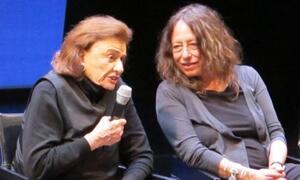Women who frame our world
Who are the women who frame our world? A small gathering of about 100 women met in San Francisco last week to hear from an array of leaders in the creative arts. Organized by Brenda Way, Artistic Director of ODC/Dance, the symposium asked not only who are these women who frame our world, but how do they do it.
The roster of women, I quickly noted, included a lot of Jews. Do Jewish women frame the world differently? Of course they do, given their legacy and upbringing. We are at the end of the generation of post-Holocaust children. My contemporaries and I, first-born American children of Eastern European immigrants with remnants of family who survived the Holocaust, bring a historical landscape into our creative work – it’s embedded in our psyche. For a younger generation of Jewish women, twice-removed from the Holocaust, their landscape intersects with technology rather than victimization. So the frame is both expanding and shifting, as will its contents.
Keynote speaker, Carol Gilligan, now an NYU professor who challenged conventional psychology’s understanding of the development of young girls and women, provided the context for the speakers that followed. Focusing on the voice of women, she says that “we free a creative voice from the blocks that have come to impede it.”
The 89-year-old sculptor Beverly Pepper, Jorie Graham (Pepper’s Pulitzer-Prize-Winning Poet and Harvard Professor daughter), Anna Halpren ( a pioneer in modern dance for therapy and healing), Liz Lerman, (choreographer and writer), and the young artist Tiffany Shlain (award-winning filmmaker familiar to many of us as the woman behind that Barbie-doll movie, “The Tribe”), intimately revealed their method, creative process, their ideas of feminism, and what’s inside their frame.
Moxie, a word akin to chutzpah, is the name of Tiffany Shlain’s production company. And maybe that is what it takes to break down barriers. She begins her talk by making a disclaimer that both her parents are feminists, and despite her blue eyes and blonde hair, she really is a Jew. After completing “The Tribe,” which she remarks, “sold like hot potato latkes,” her creative ventures shifted from defining Jewish identity to wrestling with the distraction of technology. While it brings people together and creates connectedness, she urges us all to follow her family’s tradition of an unplugged Shabbat. Her newest film, “Yelp,” cajoles us to face our fears of unplugging and urges us to plug back in to real relationships. Her work, she believes, is most successful when the film is a catalyst for conversation.
Beverly Pepper uses steel, ceramic, and iron to create monolithic landscapes and sculptures tens of feet higher than she stands. Her first job was in a factory, a lonely place for a Jewish woman from Brooklyn who wanted to be an artist. A bit raunchy in language, she said she’s seen it all . . . social realism, abstract expressionism, pop art and sharks filled with formaldehyde. But Pepper set out on her own course, traversing between homes in the US and Italy. While she creates with tools more familiar to men, her grandmother and mother were strong women who knew no boundaries. “My mother is no pussycat and ‘no’ didn’t exist.”
Pepper’s daughter, Jorie Graham, read her poetry, including one entitled, “Guantanamo.” The poem, she says, emerged “from a lineage of torture and putting people into ovens.” Technology she frets, moves people toward imagining reality in the vehicle of a virtual reality.
Liz Lerman’s book Hiking the Horizontal was published just weeks before the symposium. Her craft is making distinctions that are not based on hierarchy. The “horizontal” she says, is a metaphor for ideas that don’t compete, but provide balance. Lerman is a Guggenheim fellow, known for using unconventional body types and multi-generational dancers in her work. Yet Lerman, a Reform Jew, explains that classical ballet is her equivalent of Jewish orthodoxy, the place she says, “where I know all the rules and there is a comfort in returning to a place where I don’t have to think.” “Inquiry,” she says, “poses the opportunity to make art.” Anna Halpren, still at work at age 86, is another Guggenheim fellow who stretched the frame of dance to include untrained dancers who could engage in the transformative experience of dance for the purposes of healing and creating community.
Two days of listening to remarkable women drew me back to Carol Gilligan’s original context of a women’s voice. In an interview at the conclusion of the conference, I posed to her a different question. How is a Jewish woman’s voice different from that of other women? And why are so many Jewish women creating and filling frames?
“As a Jew,” she said, “the framework we live in is Christianity. Jews, male or female, have an outsider’s eye. But a Jewish woman is doubly an outsider, where the artist can see the frame from around it and behind it. The spark, the push, the soul, of a Jewish woman emerges from a heritage that is less about images and more about voice . . . where Jewish girls are taught that each holds a piece of the divine and are moved towards its discovery.”
Elizabeth Stone, PhD, is an educational consultant and freelance journalist in San Francisco






